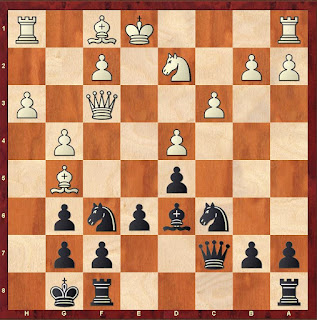Still, I will keep to my usual style, feature my personal games played, followed by a record of the other games captured. I will try to do more in-depth analysis of my own games, of course.
Long game played (without clock) -- this game lasted 3 hours or so!
Self-attempted quick review without the use of database or engine
Key learning points from the database / engines
Position after 10.g4 Bg6 11.h4 (which I thought was good for White after the game)
- After 11.h4, it is not the end of the world for Black- there are a couple of possible replies, the easiest being 11...h5! to stop the h4-pawn from opening up the Kingside. Now, if 12.Nxg6 fxg6, there will be some immediate pressure against White's Bishop on f4, Black has a semi-open f-file for the Rook on f8, White has some weaknesses on his Kingside while Black has faster development. All these should be more than adequate compensating factors to negate the weakness on e6 -- at the very least, White has no immediate way to exploit it, and eventually Black may even be able to play ...e5 if necessary to challenge White's centre and open up the position further. In a nutshell, 11.h4 would have been a inaccuracy -- 11.Nxg6, which my opponent played in the game, is correct.
Position after 11.Nxg6 fxg6 12.Bg5 Nd7 13.Qf3
- 13...Nd7, which was played (too slow), was no good. In response, the engine recommended White to play 14.h4 immediately attacking on the Kingside. Instead, the engine strongly recommends Black to exploit the fact that his development is faster and open up the position with an immediate 13...e5! White has no time to gain a pawn on f6, and will need to be very careful in address the opening up position.
Position arising after 17.Qe3
- After 17.Qe3, Black got the overall planning correct -- to do opposite side attack. However, 17...b5 is not effective (Black baited White to play 18.Bxb5, which White did not fall for). Instead, 17...a5! would be more effective -- the pawn can continue to push down the a-file, minimally gaining some Queenside space. Also, generally speaking it is correct to minimise the number of pawn advancements we make in front of our King, to delay engagement with opponent's pawn storm (which delays opening up our own King pawn cover).
Position after 25...d3 26.Bxd3 Qxa3 27.Nc4
- In this position, Black played the safe-looking 27...Qxd3, simplifying the position with a 1-pawn advantage. This was the 2nd best move (around -1 in favour Black). But the very best move here was 27...Qa4!! The point being, that should White continue usually with 28.Nxd6, Black has 28...Nb3! weaving a mating net which will result in gaining of huge material if White avoids the mate.
- Last but not least, in the final position which Black accepted a draw, Black does have some concrete advantage to press the position. (Whether it is winnable is another story.) While this may seem trivial, energy and stamina is very important, especially in the upcoming SG Amateurs 2018 Tournament. For this 9-round tournament, all but 1 day consists of 2 games! This is definitely very trying for all the players (especially adult players like myself who is out of shape... need to exercise more!)
Overall, I am still quite bad in evaluating "dynamic" positions, poor in assessing imbalance. On the bright side, I do like my ability to simplify complicated positions towards a small advantage to press. But this was played without a chess clock (at the request of my opponent). I wonder if I would play better or worse with the clocks in play -- certain moves, especially 25...d3 and 26...Qxa3, I probably spent around half an hour or so.
2 rapid (15+10) games with another opponent
Key learning points from the database / engines
- Opening-midgame: After 12.Nc3, Black should play 12...Bg4 immediately. Black waited a bit too much. After the moves 12...Rfd8, instead of 13.Qd2, White could've played 13.h3! to prevent this pin for good.
Other than this, everything else from Black was good! Well played, well-deserved win =)
Key learning points from the database / engines
- Opening: Instead of 12.Bb2, better was 12.Nd5 immediately -- It is better to ensure that Black has no ...d5 resource, and then White would have all the time in the world to improve / complete his opening play.
- 16.Qd2 that White played, was excellent! I'm glad I found it during the game on one hand, yet it got me into severe time trouble on the other hand. Still, for learning purpose, I don't mind losing the game to find the correct moves, in a sense.
Just want to make the qualifier that while I admitted I'm annoyed by certain style of play, it is perfectly legitimate. It is my problem to fix. I can't possibly request my opponent to not annoy me with his playing style, LOL. If anything psychologically, it is best to annoy the opponent as much as you can within the legal means. (And I myself am fond of chess psychology as a subject of chess study!)
Other games captured on DGT Smart Board -- I hope the Siglap South CC players would be able to identify their own games for self review purpose. They players would have to identify your own games please! Also, maybe I should teach the players how to record the results after the game.
I'm so happy that the electronic chess set is being put to good use! I was so afraid there won't be much use. Now I'm glad my $500 had been well spent ^o^
Looking forward to another
Yours sincerely
Ong Yujing (Eugene)
a.k.a. newbie_learner, scorekeeper







No comments:
Post a Comment